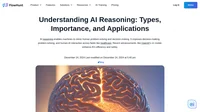Predictive modeling is a sophisticated process employed in data science and statistics to forecast future events or outcomes by analyzing patterns discovered within historical data. This process leverages statistical techniques and machine learning algorithms to uncover relationships within data sets, enabling the creation of models that can predict future trends or behaviors. Predictive modeling is a cornerstone of predictive analytics, a branch of data analytics that utilizes both current and historical data to make educated predictions about future activities. This field has gained significant traction in recent years, thanks to the advent of big data and advanced computational techniques, which have allowed for more accurate and efficient models.
Predictive Modeling Techniques
The realm of predictive modeling includes a variety of techniques, each uniquely suited for different types of data and problems:
- Linear Regression: A fundamental technique that models the relationship between a dependent variable and one or more independent variables using a linear approach. It predicts continuous outcomes and stands as one of the simplest forms of predictive modeling. Linear regression is widely used in fields like economics, biology, and engineering for its straightforward application and interpretability.
- Logistic Regression: This technique is utilized for binary classification problems, where the outcome is a probability of a certain class or event existing. Logistic regression is critical in medical statistics for predicting the presence or absence of a disease.
- Neural Networks: Inspired by the human brain’s structure, neural networks are employed for complex pattern recognition tasks. They are particularly useful in applications involving large volumes of data, such as image and speech recognition. Neural networks have revolutionized fields like artificial intelligence and machine learning due to their ability to model nonlinear relationships.
- Classification Models: These include decision trees, random forests, and support vector machines (SVM), which categorize data into predefined classes. Such models are instrumental in credit scoring and customer segmentation tasks.
- Clustering Models: Techniques like K-means clustering group data points into clusters based on similarities, which can be pivotal in customer segmentation and market research. Clustering provides insights into natural groupings within data, which is invaluable in exploratory data analysis.
- Time Series Models: Used to analyze data points collected or recorded at specific time intervals, these models forecast future values based on past observations. Time series models are extensively used in stock market analysis and economic forecasting.
- Ensemble Models: These models, such as Random Forests and Gradient Boosting Machines, combine multiple learning algorithms to achieve improved predictive performance. Ensemble models are preferred in competitions and real-world applications due to their robustness and accuracy.
Use Cases of Predictive Modeling
Predictive modeling finds applications across a diverse range of industries:
- Finance: In finance, predictive modeling is used for risk assessment, fraud detection, and forecasting market trends. It helps financial institutions anticipate market fluctuations and optimize investment strategies.
- Healthcare: Predictive models assist in disease prediction, patient outcome forecasting, and resource allocation. They are crucial in personalized medicine and public health planning.
- Marketing: Employed in customer segmentation, churn prediction, and behavioral targeting, predictive models enable marketers to tailor their strategies effectively and enhance customer engagement.
- Supply Chain Management: Used for demand forecasting and logistics optimization, predictive models help businesses streamline operations and reduce costs.
- Human Resources: Predictive modeling assists in talent acquisition and predicting employee turnover, enabling HR departments to devise effective retention strategies.
Building a Predictive Model
The creation of a predictive model involves several structured steps:
- Data Collection: Gather historical data relevant to the prediction problem. The quality and quantity of data are crucial for the model’s success.
- Data Preparation: Clean and preprocess the data to ensure accuracy and consistency. This step often involves handling missing values and outliers.
- Feature Selection: Identify and select the most relevant features or variables that influence the outcome. Feature engineering can significantly impact the model’s performance.
- Model Selection: Choose the appropriate predictive modeling technique based on the problem and data characteristics. The choice of model depends on the complexity of the problem and the type of data available.
- Training the Model: Use the training data to build the model, adjusting parameters to optimize performance. This step involves fine-tuning the model to improve accuracy and efficiency.
- Model Evaluation: Validate the model against test data to assess its accuracy and reliability. Cross-validation techniques are often used to ensure the model’s robustness.
- Deployment: Implement the model in a real-world setting to make predictions on new data. The deployment phase includes monitoring the model’s performance and updating it as necessary.
Challenges in Predictive Modeling
Predictive modeling faces several challenges, including:
- Data Quality: Ensuring that the data used is clean, accurate, and representative of the problem space. Poor data quality can lead to unreliable predictions.
- Model Overfitting: Avoiding a model that fits the training data too closely and fails to generalize to new data. Techniques like regularization and cross-validation help mitigate overfitting.
- Bias and Fairness: Addressing biases in the data that could lead to unfair or inaccurate predictions. Ensuring fairness is critical, especially in sensitive applications like criminal justice and hiring.
- Interpretability: Balancing model complexity with the need for interpretations that stakeholders can understand. Transparent models are often preferred in industries like healthcare and finance.
Connection to AI and Automation
In the context of AI, predictive modeling plays a crucial role in the development of intelligent systems such as chatbots and virtual assistants. These systems rely on predictive models to understand and anticipate user needs, improve user interaction, and provide personalized responses. The integration of predictive modeling with AI technologies enhances automation capabilities, making AI systems more adaptive and accurate in decision-making processes. Predictive modeling fuels innovations in natural language processing, recommendation systems, and autonomous vehicles.
Predictive Modeling: An Overview
Predictive modeling is a technique used to forecast outcomes by analyzing patterns from historical data. It is an essential tool in fields such as healthcare, energy management, and machine learning. Below are some notable studies that contribute to the understanding and advancement of predictive modeling:
- Continual Prediction from EHR Data for Inpatient Acute Kidney Injury by Rohit J. Kate et al. (2019) focuses on predicting acute kidney injury (AKI) in hospitalized patients using electronic health records (EHR). The study introduces a novel framework for continuously predicting AKI throughout a hospital stay, rather than at a single point in time. This continual prediction model leverages the most recent patient data, resulting in higher accuracy compared to traditional one-time prediction models. The model achieved an area under the ROC curve (AUC) of 0.724, outperforming the one-time prediction models which had lower AUC scores. The continual approach demonstrated significant improvement in early AKI prediction, which is crucial for timely medical intervention. Read more.
- Electricity Price Prediction for Energy Storage System Arbitrage: A Decision-focused Approach by Linwei Sang et al. (2023) highlights the importance of electricity price prediction in managing energy storage systems (ESS). The research proposes a decision-focused prediction model that integrates downstream decision-making impact with prediction accuracy. By considering both prediction and decision errors, the study improves economic benefits and reduces decision errors in ESS arbitrage. The approach optimizes the balance between prediction accuracy and decision-making effectiveness, leading to better financial outcomes in energy markets. Read more.
- Learning Discriminators as Energy Networks in Adversarial Learning by Pingbo Pan et al. (2018) explores the use of adversarial learning in structured prediction models. The study introduces a framework where discriminative models complement structured prediction models during training. This approach enhances the prediction models by utilizing discriminator information at the inference stage, improving the predictive performance on structured data. The integration of adversarial learning techniques presents a novel way to refine predictive models for complex data structures. Read more.
Feature Engineering and Extraction
Explore how Feature Engineering and Extraction boost AI model performance by transforming raw data into valuable insights. Learn key techniques and examples!
Understanding AI Reasoning: Types, Importance, and Applications
Explore AI reasoning types, importance, and applications in healthcare and beyond. Discover how AI enhances decision-making and innovation.



